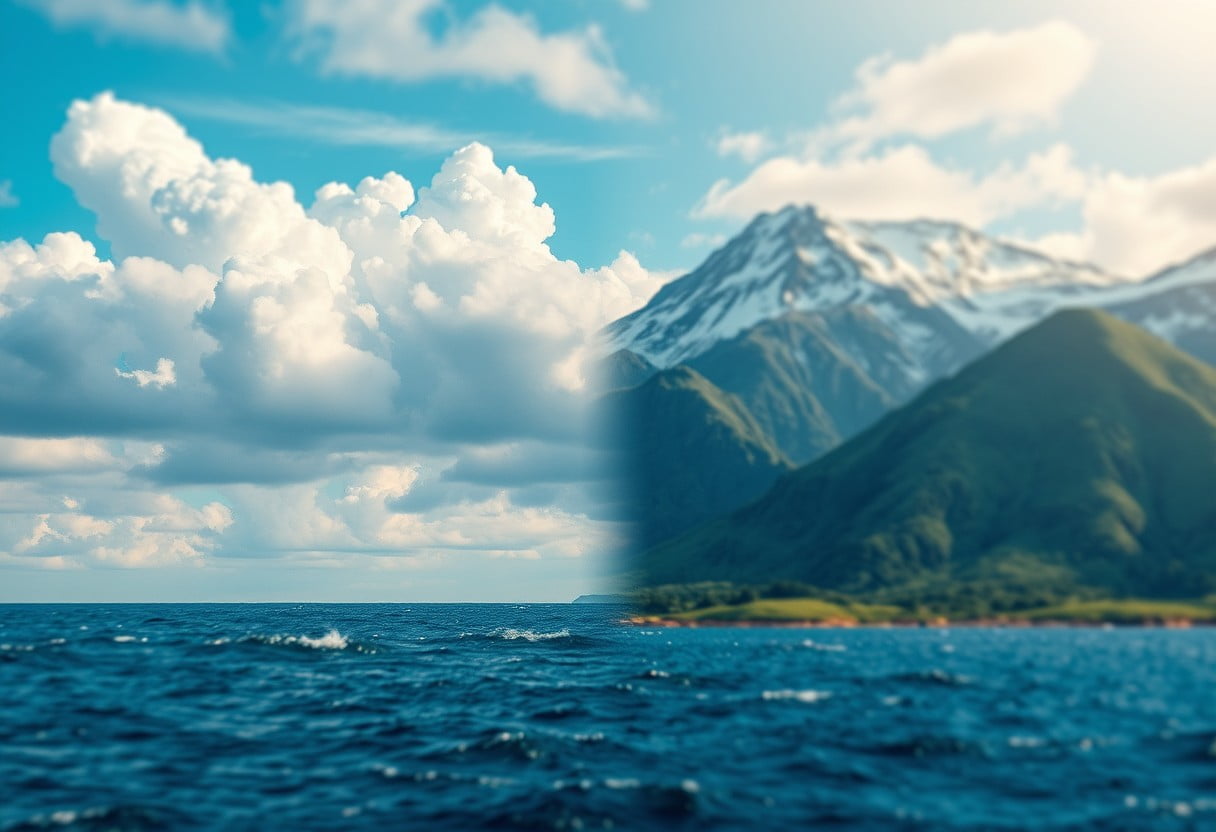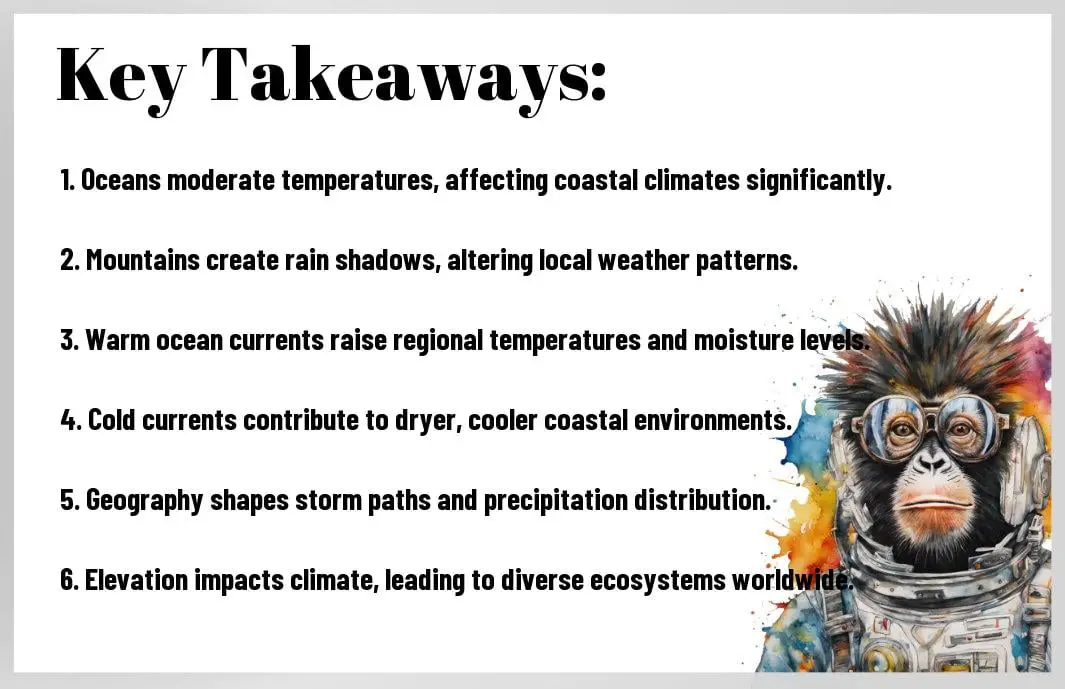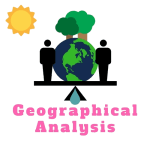Just as your surroundings shape your experiences, the geography of our planet profoundly impacts weather patterns and climate. Understanding how oceans and mountains interact with atmospheric conditions will deepen your appreciation for the intricate balance of nature. From the cooling effects of ocean currents to the rain shadows created by mountain ranges, these geographical features play a crucial role in determining local climates and weather events. This post will guide you through the significant influences of oceans and mountains, equipping you with knowledge to comprehend the dynamic systems that affect your environment.

Key Takeaways:
- Geographical Features: Oceans and mountains play a crucial role in shaping weather patterns and climate.
- Ocean Currents: The movement of ocean currents affects temperature and precipitation, influencing climate zones around the globe.
- Wind Patterns: Mountains can block or deflect wind patterns, leading to varied climates on either side (rain shadow effect).
- Temperature Regulation: Large bodies of water help to regulate temperature by absorbing heat, which influences regional climates.
- Climate Change Impact: Understanding the interaction between geography and climate is vital for addressing climate change and its effects on ecosystems.


The Role of Oceans in Climate Regulation
Your understanding of climate regulation expands significantly when you realize the crucial role that oceans play in this process. Oceans not only store vast amounts of solar energy but also help distribute it around the planet through their currents. These ocean currents act as a conveyer belt, moderating temperatures and influencing weather patterns globally. The interplay between these powerful currents and the ambient atmosphere is crucial for maintaining a balanced climate, impacting everything from precipitation patterns to storm activity.
Ocean Currents and Temperature Distribution
Any discussion about the role of oceans in climate regulation would be incomplete without considering ocean currents and their effect on temperature distribution. These currents, driven by wind patterns and the Earth’s rotation, significantly alter the climate of coastal regions and can even have far-reaching effects on continents far removed from the ocean.
| Current | Effect on Climate |
| Gulf Stream | Warms the northeastern US and parts of Europe, creating milder winters. |
| California Current | Cools the coastal regions of California, contributing to a dry climate. |
| Kuroshio Current | Warms the east coast of Japan, fostering tropical cyclone formations. |
The Influence of El Niño and La Niña
Any conversation about climate regulation must also touch on the complex phenomena of El Niño and La Niña. These oscillations in ocean temperatures significantly affect global weather patterns, leading to severe weather events such as floods, droughts, and hurricanes. Understanding these phenomena can help you predict and prepare for these extreme weather conditions, as their effects can be felt worldwide.
Oceans serve as the heat engine for these patterns, with El Niño characterized by warmer ocean temperatures in the equatorial Pacific, leading to increased rainfall in some regions and drought in others. Conversely, La Niña is marked by cooler-than-average sea surface temperatures, which can disrupt localized weather patterns, often leading to drier conditions in some areas and wetter conditions in others
Ocean Heat Content and Weather Extremes
On a broader scale, ocean heat content plays a vital role in shaping weather extremes. The amount of heat absorbed by oceans affects atmospheric conditions, which can lead to an increase in the frequency and intensity of storms and other weather-related disasters. Higher ocean temperatures can fuel hurricanes, making them more powerful and longer-lasting, while also contributing to heavier rainfall in affected areas.
Climate scientists are increasingly focusing on the correlation between ocean heat content and extreme weather incidents. When ocean waters are warmer, more moisture is released into the atmosphere, which can intensify precipitation events and lead to devastating floods. This relationship emphasizes the importance of monitoring ocean temperatures as part of ongoing climate research.
The Impact of Oceans on Humidity Levels
Ocean moisture is another crucial factor in climate regulation that directly influences humidity levels. As oceans evaporate, they release water vapor into the atmosphere, which is crucial for maintaining the Earth’s hydrological cycle. The balance of this moisture affects weather patterns, including precipitation, cloud formation, and temperature variations.
The interconnectedness of oceans and humidity levels cannot be overstated. Regions near large bodies of water often experience higher humidity levels, impacting local climates significantly. This moisture influences not just weather but can also have profound effects on agriculture, public health, and even energy consumption in surrounding areas.

The Influence of Mountains on Weather Patterns
Despite their majestic beauty, mountains play a significant role in shaping weather patterns and climate. Their towering presence can alter air flow and create distinct climatic zones, leading to variations in precipitation and temperature not just locally, but across vast regions. As you explore the influence of mountains on weather, you will see how these natural barriers interact with atmospheric elements to create unique environments.
Orographic Lift and Precipitation
The phenomenon of orographic lift occurs when moist air is forced to ascend over mountain ranges. As the air rises, it cools and condenses, resulting in precipitation on the windward side of the mountains. This is why mountain ranges often have lush, green forests and abundant rainfall in these areas. Understanding orographic lift can provide invaluable insights into weather forecasts and local climate behavior, allowing you to appreciate the vital role mountains play in hydrology.
Once the air reaches the peak and begins its descent on the leeward side, it warms up and can hold more moisture. This leads to a significant decrease in precipitation, highlighting the dramatic differences in climate that can exist over short distances in mountainous terrain. You can see the impact of orographic lift firsthand, as it creates diverse ecosystems and agricultural practices on either side of a mountain range.
Rain Shadows: The Dry Side of Mountains
Rain shadows are phenomenons that occur in the areas of reduced precipitation on the leeward side of the mountains, where the majority of the moist air has already been lost as rain. This dry region contrasts sharply with the lush greenery of the windward side, painting a vivid picture of how mountains influence local climates. Rain shadows often lead to arid and semi-arid conditions, which can dramatically affect the flora, fauna, and human activities in these regions.
Shadows of the mountains not only shape ecosystems but can also impact agricultural choices and water resource management. Regions in rain shadows often become more reliant on irrigation or innovative agricultural practices to combat the scarcity of water. Recognizing the existence of rain shadows can help you to understand the broader implications of geography on human habitation and land use.
Mountain-Induced Wind Patterns
Shadows formed by towering mountain ranges can also give rise to unique wind patterns that affect weather and climate. As air travels across a land mass, it can be deflected by the presence of mountains, leading to changes in wind direction and speed. This alteration can influence weather conditions far beyond the immediate vicinity of the mountains themselves. For instance, you may notice that some valleys experience stronger winds as a result of this displacement, which can affect temperature and humidity levels locally.
Patterns of wind shaped by mountain ranges can also contribute to the development of local climates characterized by high winds or localized weather phenomena. This understanding allows you to predict potential changes in temperature and precipitation in different areas and appreciate the complex interactions at play in mountainous regions.
Altitude and Temperature Variations
Mountains are often characterized by significant altitude changes, which correlate directly with temperature variations. As you ascend a mountain, temperatures typically decrease due to the thinning atmosphere. Several key factors can influence how altitude affects temperature, including geographical location, season, and overall climate. Understanding this relationship is crucial in appreciating the unique environments that mountains provide.
Temperature Variation Factors
| Factor | Description |
|---|---|
| Altitude | Higher altitudes generally lead to lower temperatures. |
| Geographical Location | Temperature can vary significantly based on latitude and proximity to oceans or currents. |
| Seasonality | Temperature changes are often more pronounced during certain seasons, depending on local climate. |
Patterns of temperature variation at different altitudes can significantly influence the types of vegetation, wildlife, and human activities in mountainous regions. As such, an appreciation for altitude and temperature dynamics enables you to better forecast weather patterns and informs land management practices in these diverse environments.
The Interplay Between Oceans and Mountains
Keep in mind that the interaction between oceans and mountains creates a unique and complex system that significantly influences our climate. These geographical features can alter weather patterns, leading to varied climates that can be experienced in adjacent regions. Coastal mountains and the nearby ocean can generate specific weather phenomena that are distinct from the environments found further inland. By examining these relationships, you can gain a greater appreciation for how vital geography is in shaping local climates.
Coastal Mountains and Marine Climates
One fascinating aspect of coastal mountains is how they interact with marine climates to create specialized weather patterns. As moist air from the ocean moves towards land, it encounters the mountains, which force it to rise. This rising air cools, condensing and leading to increased precipitation on the windward side. This phenomenon contributes to the lush, dense forests that often thrive in these regions, while areas on the leeward side may remain arid due to the rain shadow effect. Understanding this dynamic can enhance your grasp of ecological zones and the biodiversity that flourishes in these varied conditions.
Additionally, the proximity of coastal mountains to the ocean leads to temperature moderations that characterize marine climates. The interplay decreases temperature extremes and enhances overall humidity levels. Therefore, if you live near such geographical features, you may notice milder winters and cooler summers compared to inland areas. Recognizing these effects can help you appreciate the intricate balance between elevation, oceanic influences, and local weather patterns.
Oceanic Feedback Mechanisms
Any significant changes in ocean temperatures can initiate complex feedback mechanisms that heavily influence climate. These dynamic interactions between oceanic and atmospheric systems can lead to shifts in temperature, precipitation patterns, and even storm intensity. Understanding these mechanisms can inform you on how something as vast as the ocean can sway local weather conditions and contribute to overall climate trends. It emphasizes the interconnectedness of our planet’s systems and how changes in one can reverberate throughout others.
Oceanic feedback mechanisms predominantly arise from the exchange of heat and moisture between the ocean and the atmosphere. The ocean acts as a heat reservoir, absorbing and redistributing thermal energy, while simultaneously influencing atmospheric circulation. Events such as El Niño and La Niña highlight these mechanisms, causing significant fluctuations in weather patterns globally. As you consider these interactions, you may gain insights into forecasting and the potential impacts of climate change on both oceanic and terrestrial systems.
How Mountains Affect Sea Surface Temperatures
Mountains influence sea surface temperatures through three primary mechanisms: barrier effects, elevation-induced wind patterns, and differential heating. When mountains obstruct prevailing winds, they can create localized temperature variations across the adjacent sea surface, as the airflow gets channeled or diverted. This effect leads to disparities in heating and cooling of marine areas adjacent to mountainous regions, impacting local climates. If you want to understand these variations on a deeper level, examining the specific scenarios with surrounding land and sea interactions will be insightful.
Mechanisms of Influence on Sea Surface Temperatures
| Mechanism | Description |
|---|---|
| Barrier Effects | Mountains can block winds, affecting heat exchange and creating temperature gradients in coastal waters. |
| Elevation-Induced Winds | Changes in wind patterns due to elevation can impact evaporation rates and heat distribution over the ocean. |
| Differential Heating | Various altitudes cause different heating rates, resulting in unique thermal profiles over nearby waters. |
Another important aspect to note is how these mechanisms contribute to larger climatic patterns, such as ocean currents, which circulate warm and cold water across vast distances. As the sea surface temperatures change, they can influence weather systems not just locally but also in distant regions. Therefore, understanding the role of mountains in affecting sea surface temperatures is not only crucial for grasping microclimates but also for recognizing how they shape macro-scale climatic trends across the globe.
Impact of Temperature Variations
| Temperature Variation | Impact |
|---|---|
| Increased Sea Surface Temperature | Can lead to stronger storms and shifted weather patterns, affecting both marine life and coastal communities. |
| Decreased Sea Surface Temperature | Can result in cooler, nutrient-rich waters that support diverse marine ecosystems but may also disrupt fishing industries. |
The Effect of Geography on Climate Zones
Not everyone realizes how intricately geography weaves into the fabric of our climate zones. The variations in physical geography, including mountains, oceans, and plains, create diverse climates that impact both everyday weather and long-term climate patterns globally. For instance, if you’re interested in understanding the relationship between climate and geography in the context of the United States, you may consider exploring America’s Climates and Physical Geography. This resource sheds light on how local geography shapes the specific climates experienced across the nation.
Tropical vs. Polar Climates: A Geographic Perspective
Perspective matters when examining the stark contrast between tropical and polar climates shaped by their geographical locations. Tropical climates, often found near the equator, benefit from direct sunlight throughout the year, leading to warm temperatures and abundant rainfall. Conversely, polar climates, which hover around the poles, are characterized by significantly colder temperatures and precipitation largely in the form of snow due to the high angle of sunlight that barely penetrates during the polar winter. When you understand this relationship, it becomes clear how vital latitude and local geography are in determining climate.
Microclimates: The Role of Local Topography
Topography plays a critical role in shaping microclimates, which are localized weather patterns occurring in specific areas due to geographical features. You may find that small shifts in elevation or proximity to water bodies can lead to notably different climatic conditions within short distances. For example, urban areas can sometimes create heat islands, where temperatures are elevated due to human activities, while nearby forests may retain much cooler environments. This mix illustrates how local topographic features can dramatically influence temperature, humidity, and precipitation in your surroundings.
The interaction of various elements—such as elevation, vegetation, and water bodies—creates unique microclimates. Mountains can block prevailing winds, causing one side to experience heavy rainfall while leaving the other in relative dryness, a phenomenon known as the rain shadow effect. Also, bodies of water often moderate temperature fluctuations in coastal regions, leading to milder climates compared to inland areas. Recognizing the significance of these nuances allows you to appreciate the climatic diversity that’s often found within a single region.
The Distribution of Biomes and Their Climate Correlates
Distribution of biomes links closely to geography and prevailing climate conditions. Each biome, such as deserts, forests, and tundras, reflects the climate characteristics typical of its geographic zone. For example, you might notice how tropical rainforests, situated near the equator, thrive in the warm and moist climate, while deserts, often found at latitudes around 30 degrees north and south, reflect arid conditions and sparse vegetation. This direct correlation between geography and biome distribution highlights how critical it is to understand the climate patterns to evaluate ecological diversity.
A deeper examine how climate correlates with biomes reveals that various ecosystems adapt uniquely to their geographic contexts. For instance, grasslands generally emerge in regions where rainfall is insufficient to support tree growth, while temperate deciduous forests form in areas with sufficient moisture and seasonal temperature variations. These relationships demonstrate that geography does not merely influence climate but also orchestrates the thriving communities of plants and animals found in different biomes worldwide.
Climate Change and Geographical Influences
Now, as climate change continues to reshape our planet, understanding the intricate relationship between geographic features and weather patterns becomes imperative. The oceans and mountains, which have long dictated the climate dynamics of various regions, are increasingly influenced by human activities and the repercussions of global warming. This chapter will research into how these geographical elements interact with changing climate conditions and the resulting global impact.
Ocean Stratification and Climate Feedbacks
On the surface of the ocean, a complex layering system known as stratification occurs. This phenomenon is defined by variations in temperature, salinity, and density, which create distinct layers of water that resist mixing. As climate change progresses, these layers are affected more intensely, leading to changes in ocean circulation patterns that subsequently influence weather systems and climate feedback loops. For instance, warmer surface waters can result in reduced nutrient upwelling, impacting marine ecosystems and altering weather patterns over extensive areas.
The feedback mechanisms activated by ocean stratification can have profound implications for climate stability. Such changes might lead to increased storm intensity or altered precipitation patterns, influencing agriculture and water resources far beyond coastal zones. By understanding these interactions, you can gain insights into how climate forecasts and mitigation strategies may need to evolve to account for these dynamic oceanic influences.
The Changing Role of Mountains in Weather Patterns
Change is a constant when it comes to the influence of mountains on weather and climate. As the planet warms, mountain regions experience shifts in precipitation and temperature that can drastically alter local ecosystems and weather patterns. For instance, melting glaciers that once provided steady runoff are now creating challenges for water supply in areas that depend on these resources during drier seasons. Additionally, altered wind patterns due to warming can modify precipitation distributions, affecting habitats and communities situated in the mountains and valleys.
The interplay between changed weather patterns and mountain geography can lead to unpredictable weather events. You may notice that areas previously unaffected by heavy snow or rainfall are now experiencing extreme weather, raising concerns about landslides and flooding. As mountain ecosystems struggle to adapt, you may witness shifts in flora and fauna, as many species find their established habitats becoming less hospitable due to these rapid changes.
Human Impact on Ocean and Mountain Dynamics
Change has accelerated due to human activities, particularly through carbon emissions and land-use alterations. These shifts do not merely affect the climate but also the natural equilibrium within ocean and mountain ecosystems. The rising temperatures lead to ocean acidification and altered fish migration patterns, while deforestation and urbanization in mountainous areas contribute to soil erosion and habitat loss. As you observe these changes, it’s crucial to understand how interconnected these systems are and the ripple effects they can produce on a global scale.
It is imperative to recognize that your actions contribute to the ongoing changes in these vital geographic features. Whether through energy consumption habits, support for sustainable practices, or advocacy for climate action, your choices can influence how these ecosystems adapt to the pressures of climate change. By understanding and addressing human impacts, you can play a role in shaping a more sustainable future for both oceans and mountains.
Tools for Studying Geography’s Influence on Climate
To understand the intricate relationship between geography and climate, it is important to leverage various tools that provide detailed insights. These tools allow you to collect data, analyze patterns, and ultimately make informed conclusions regarding how oceans, mountains, and other geographical features impact weather systems and long-term climate trends. Among these tools, satellite observations and remote sensing stand out as important instruments in the modern climatologist’s arsenal.
Satellite Observations and Remote Sensing
Sensing technology has transformed the way you gather data about our planet’s climate. Satellite observations offer a bird’s-eye view of the earth, measuring variables such as temperature, humidity, cloud cover, and vegetation from space. By capturing large swathes of data, satellites help you visualize and analyze how different geographical features interact with atmospheric conditions to create distinct climates across various regions.
Moreover, remote sensing enables you to monitor changes over time, facilitating the study of trends related to climate change, natural disasters, and human impact. This capacity to evaluate real-time data helps you better understand the ongoing shifts in climate patterns and how they correlate with geographic factors, enhancing your knowledge of global climate dynamics.
Climate Modeling and Geographic Information Systems (GIS)
Sensing plays a pivotal role in climate modeling and GIS, which are critical for understanding long-term climate scenarios. Climate modeling incorporates vast datasets—including satellite observations and ground-based measurements—to simulate future climate conditions across different geographic landscapes. GIS technology complements this by allowing you to visualize and manipulate spatial data, enabling clearer assessments of how geography influences climate systems.
Plus, with the amalgamation of climate models and geographic data, you can quantify the potential impacts of climate change on specific regions while considering the myriad interaction factors such as topography and proximity to oceans. This powerful combination allows you to create more accurate predictions and formulations that help guide policy discussions and conservation efforts.
Paleoclimate Studies and Historical Perspectives
Remote investigation into paleoclimate studies unveils insights into how earth’s climate has evolved over millennia. By analyzing ice cores, sediment layers, and fossil records, you can reconstruct past climates to see how geographical configurations have influenced climate changes through time. The knowledge gained from such historical perspectives can be pivotal in understanding present-day climate dynamics and forecasting future trends.
To better grasp the nuances of paleoclimate studies, recognize that they not only inform you about the natural climate variability but also provide context for human impact on climate. By understanding how the Earth’s geography has shaped climate over thousands of years, you can better grasp your role in the ongoing climate crisis and the importance of making informed decisions based on historical data and current geographical trends.
Summing up
Taking this into account, it is clear that geography plays a crucial role in shaping weather patterns and climate across the globe. As you consider the intricate relationship between oceans, mountains, and atmospheric conditions, it becomes apparent that their influence extends far beyond mere physical boundaries. Oceans regulate temperature and moisture levels, while mountains act as barriers that can define climate zones and precipitation patterns. Understanding these geographical factors empowers you to comprehend the complexities of weather variations and climate changes, as well as their potential impacts on ecosystems and human activities.
Furthermore, recognizing the power of geography can enhance your appreciation for the planet’s diverse climates and weather phenomena. As you become more aware of how ocean currents and mountainous terrains affect your local environment and contribute to global climate systems, you can better anticipate challenges and opportunities related to climate change and environmental sustainability. By engaging with this knowledge, you not only strengthen your understanding of the natural world but also equip yourself with insights that can inform your actions toward a more sustainable future.



